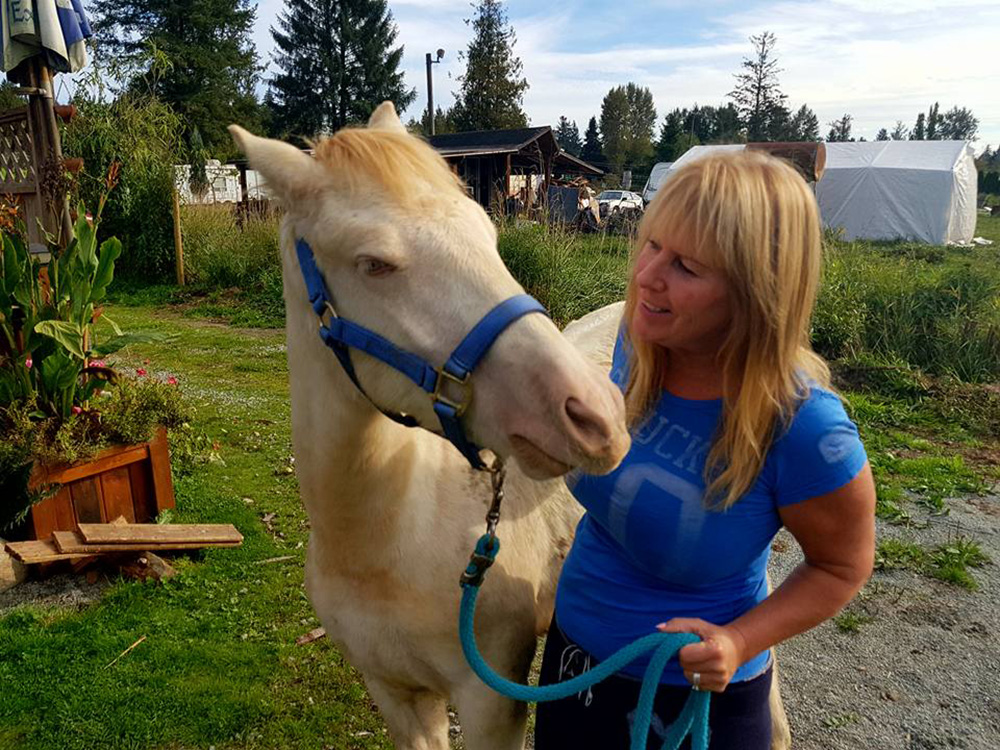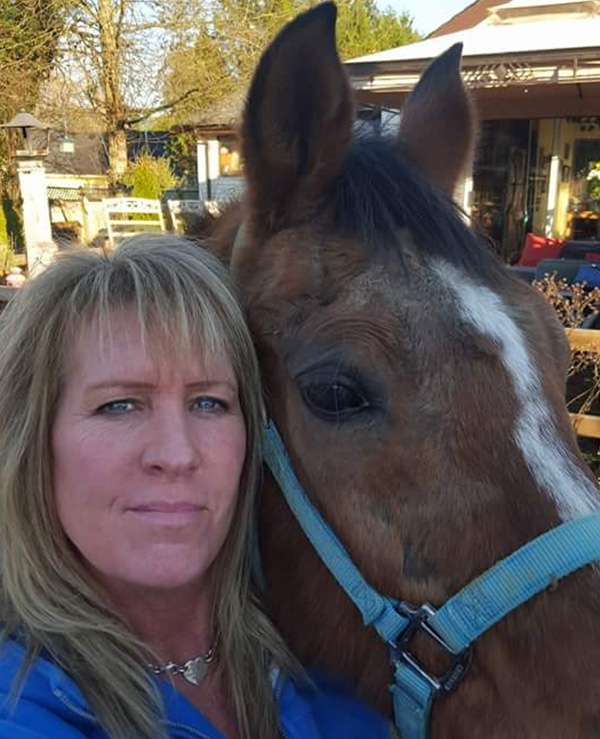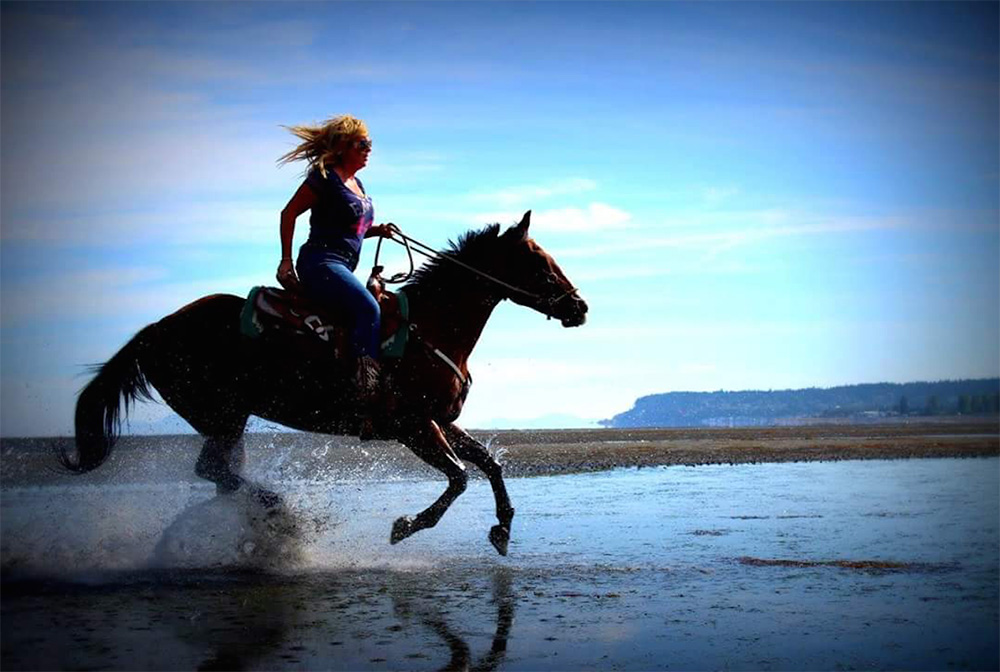Julie MacMillan was visiting a Lower Mainland livestock auction back in 1995 when she noticed something odd.
“I just went because I thought it would be fun to look at horses,” she recalls, “and I remember seeing this big group of horses being led onto a semi by a guy who wasn’t being kind to them at all — he was beating them in the head and things like that. So I asked other people ‘What the hell is going on here?’”
As MacMillan quickly discovered, the man was what’s known as a “Kill Buyer” — someone on the front lines of a little-known Canadian industry that brings in more than $80 million in export revenue per year: horse meat.
“This was the first time I discovered that horse slaughter existed,” she explains. “Like most people, I had no idea it even happened.”
Determined to do something, she raised enough in donations to purchase her first horse, dubbed “Lucky,” at auction later that same year. Not long afterward, she founded J&M Acres, an all-breed horse rescue organization based out of her two-acre Maple Ridge farm. And over the past 20 years, relying only on donations and her own wallet, MacMillan has rescued more than 1,000 horses — between 40 and 60 a year — from Canada’s slaughter pipeline, rehabilitating them and finding them permanent homes.
“It started out really, really slowly,” MacMillan says. “I bought one horse, and then another, and had a few spare bucks to buy a third one. And over the years, it’s just snowballed more and more and more. And the reach we’ve got has grown huge.”
An ‘anti-profit’ organization
Born and raised in the British Properties in West Vancouver, MacMillan got her first horse at 13, and “it’s been a love affair ever since.” After years in restaurant management and as a partner in a pub, she recently moved back into serving, in order to make more time for her work with J&M.
“I don’t know how she does it,” muses neighbour Cheryl Sterling, who has, to date, adopted seven horses through — or because of — MacMillan. “She keeps saying she’s going to step back, but then she gets a phone call from the auction authority, and they’ll say ‘Oh, we’ve got two more,’ and she’ll go down and see what she has room for.”
During a brief period in the early 2000s, MacMillan received a stipend from Greener Pastures, a standardbred rescue group she founded at Fraser Downs racetrack in Surrey. However she quickly developed misgivings about the combination of animals and money, and today, J&M remains a decidedly volunteer effort.
“It isn’t even a non-profit,” she chuckles. “It’s an anti-profit. There’s never been an income pulled out of it. It’s all done from the heart. Which I think is a better way to do things. You mix animals and money, and it’s not good for the animals. Ever.”
No matter where she works, she explains, people’s reaction to news of the horse meat industry is always the same.
“People have no idea,” she says. “Ever. They’re completely blindsided by it.”

While effectively banned in the U.S., Canada remains one of the largest exporters of horse meat in the world, much of that going to Japan (where it’s consumed as sashimi) and EU countries like France and Switzerland. And while the industry is relatively small when compared to beef or poultry ($2.3 billion and $522 million in annual export revenue, respectively), horse meat has been Canada’s top red meat export to Europe.
It appears occasionally on plates in Canada, too, mostly in the province of Quebec.
According to the federal agriculture department, 54,147 horses were slaughtered in Canada in 2016 — at least half of those imported from the U.S., and virtually all purchased at livestock auctions by buyers who pay by the pound.
In recent years, equine auctions in the Lower Mainland have mostly come to a halt. Here, the animals end up in general livestock auctions, where J&M and other rescues take as many as they can. “These days, I end up with almost everything that’s salvageable that goes to auction in the Lower Mainland,” MacMillan notes.
But in Alberta and B.C.’s Interior, horse auctions are still common, and MacMillan estimates half the horses are purchased for slaughter. The Ontario Livestock Exchange reports 69.2 per cent of the horses sold at auction in that province in 2013 went to kill facilities.
But unlike other industries, none of these animals were originally raised for meat. In fact, most were either pets or retired race or trail-riding horses. While ostensibly regulated by Agriculture and Agri-Food Canada, actual oversight is minimal, leading to rampant fraud.
“Stolen horses, wild horses caught and sold for slaughter, and thousands of family pets, rodeo horses, and ex-racehorses enter the slaughter pipeline every year,” says Sinikka Crosland of the Canadian Horse Defence Coalition. “When there is money to be made from horse flesh, there is also an incentive for unscrupulous dealers to falsify information to ensure that horses can be sold for slaughter.”
Critics say the treatment of horses once they’re sold is also shoddy. In Canada, there are four establishments federally licensed to slaughter horses — two in Alberta and two in Quebec. All four have been investigated by the Canadian Food Inspection Agency, and independent investigations conducted by CHDC have uncovered widespread fraud and inhumane practices at three of them (Bouvry Exports, Viandes de la Petite Nation and Viande Richelieu). A fifth, located just outside of Kamloops, B.C., has been given multiple licence suspensions — the most recent of which was for its “inability to meet requirements related to the stunning of animals prior to slaughter.” As of summer 2017, it was under new ownership.
“They’re pets,” MacMillan fumes. “You don’t name a thing and have it trust you, and take your kids for rides, and then sell it by the pound. At the very least, people need to know that’s what happens to their pets, or the horses they bet on at the track.”
And as both MacMillan and Crosland point out, concerns surrounding the consumption of horse meat extend beyond the ethical.
Because there are no federal laws that address horse auctions specifically, horses destined for slaughter can be in varying levels of health. And since most have been used as pleasure animals or racehorses, their meat can be contaminated by all manner of substances harmful to humans, including phenylbutazone, a common horse painkiller that can — albeit rarely — cause all manner of adverse effects, including vomiting, gastric ulceration, renal failure, and toxic epidermal necrolysis (a syndrome where the skin blisters and peels off).
“When you put a horse into a kill auction, you have to sign paperwork that says a horse has never been given [phenylbutazone],” MacMillan says. “There’s no way that’s happening. Every horse has had it. It would be like finding a person who has never taken a Tylenol. The paperwork is BS.”
Part of the reason for the shoddy paperwork is that, unlike cattle, bison, sheep and pigs, there are no mandatory identification provisions for horses in Canada. Animals destined for slaughter require only a valid Equine Information Document, which gives the animal’s history, and asserts that it has been drug-free for six months. And while owners are legally required to provide accurate information, CFIA requires no supporting evidence and leaves oversight to the slaughterhouses themselves.
With a regulatory framework that’s essentially based on the honour system, those documents are routinely doctored or incomplete and CFIA’s drug testing is grossly inadequate. According to a 2014 Global News investigation, between 2010 and 2014 CFIA inspectors tested fewer than 400 samples per year — less than one per cent of all horses slaughtered).
Currently, EU regulations prohibit horses that have ever been treated with phenylbutazone from entering the food chain. Yet, in 2012 European regulators seized a shipment of Canadian horse meat that tested positive for clenbutrol (a performance enhancer) and phenylbutazone. A 2014 audit by the European Commission’s Food and Veterinary Office cited “serious concerns in relation to the reliability of the controls over both imported and domestic horses destined for export to the EU.”
“It’s largely unregulated,” Crosland says of the industry. “The potential for fraud is always there, and we have seen it happen on numerous occasions. The CFIA trusts the plant operators to be honest, and in turn the plant operators must trust that feedlot operators are being above board with their practices. Unfortunately, we have seen the reality: a predatory industry that doesn’t cover for human health, let alone animal welfare.”

‘It’s the overbreeding that has to stop’
In spite of all this, MacMillan does her utmost to maintain cordial relationships with both Kill Buyers and auction personnel.
“It’s just a job to them,” she says. “It’s all dollars and cents. They’re farmers. It’s no different than cows or pigs or chickens. And if you deal with them in a civilized fashion, and you pay for these horses, they’re happy for them to go to a good home.”
MacMillan no longer attends the auctions herself, instead working with auction staff to make horse purchases. Unfortunately, she notes, not every rescue organization manages to maintain that same level of detachment.
“When you’re getting into something like this, even if your intentions are good, you have to watch it,” she warns. “Some of the rescue groups are a bit overzealous — they’ll be screaming and crying — and as a result, some auctions have banned rescue groups from even attending. I get why people do it, but it’s not helping anybody.”
Luckily for those rescue groups, things do appear to be changing. Since the boom in the early 2000s, horse meat in Canada has been on the decline (the roughly 54,000 slaughtered in 2016 is a sharp decrease from the nearly 68,000 slaughtered in 2015). New regulatory changes announced by the EU are going to put a big dent in U.S. imports. That said, MacMillan harbours no illusions that the industry is going to disappear overnight — or likely at all.
“It’s not the slaughterhouses, it’s not the buyers, it’s not anybody’s fault,” she says. “It’s overbreeding. It’s backyard horses, or racetracks allowing it to happen. If it weren’t for the slaughterhouses, where would the 60,000 horses that died last year go? There aren’t homes for an extra 60,000 horses a year. It’s the overbreeding that has to stop.”
For her part, MacMillan has no plans to ride off into the sunset just yet. As a testament to her commitment, one of the farm’s permanent residents is Digger, a one-eyed, nearly 40-year-old horse who was her second-ever rescue back in 1995 and has been with her ever since. J&M’s website is filled with success stories from those who have adopted or donated over the past 20 years and the group’s Facebook page has more than 11,000 likes.
“I think it’s great, what she’s doing,” says neighbour Sterling. “I have the most wonderful horses because of her. It’s so sad. The horses aren’t [at auction] for families. They’re there for meat. But thankfully, people like Julie can save them from that.”
But no matter how many years have gone by, for MacMillan the mission remains the same as it was in 1995: take it slowly. Rescue one horse. Then another. And let her reach continue to grow.
“I’ve resigned myself to the fact that, no matter how many years I do this, I’m never going to see the problem solved,” she admits. “Horses are going to die. I can't stop that. But if I buy one horse, that horse isn’t going to die. All I can do is take it one at a time. And that’s a whole lot better than none at a time.”
The B.C. Ministry of Agriculture did not respond to questions about this story. ![]()
Read more: Rights + Justice, Food
















Tyee Commenting Guidelines
Comments that violate guidelines risk being deleted, and violations may result in a temporary or permanent user ban. Maintain the spirit of good conversation to stay in the discussion.
*Please note The Tyee is not a forum for spreading misinformation about COVID-19, denying its existence or minimizing its risk to public health.
Do:
Do not: